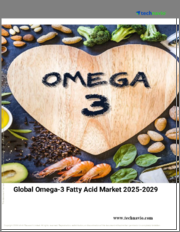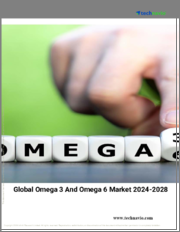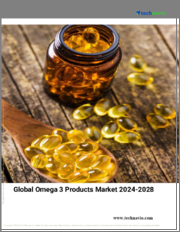
|
시장보고서
상품코드
1468208
오메가 3 성분 시장 보고서 : 유형별, 공급원별, 용도별, 지역별(2024-2032년)Omega 3 Ingredients Market Report by Type (Alpha-linolenic Acid, Docosahexaenoic Acid, Eicosapentaenoic Acid ), Source, Application, and Region 2024-2032 |
||||||
오메가 3 성분 세계 시장 규모는 2023년 29억 달러에 달했습니다. 향후 IMARC Group은 2032년까지 64억 달러에 달할 것으로 예상하며, 2024년부터 2032년까지 9.08%의 연평균 성장률(CAGR)을 기록할 것으로 예측하고 있습니다.
오메가 3 성분은 자연적으로 존재하는 고도 불포화 지방산(PUFA)으로 인간의 최적의 건강에 필수적인 영양소입니다. 오메가 3 성분은 생선, 아마씨, 건강보조식품(해조류, 크릴, 참치, 어유 등)에 널리 함유되어 있으며, 알파-리놀레산(ALA), 에이코사펜타엔산(EPA), 도코사헥사엔산(DHA)은 일반적인 성분의 일종입니다. 오메가 3 성분은 세포벽을 구성하고 에너지를 공급하며 심장, 혈관, 폐, 면역계, 내분비계가 최적의 기능을 유지하도록 돕습니다. 따라서 영양보충제, 유아용 조제분유, 임상영양학, 반려동물 사료, 기능성 식품 및 식음료 등 다양한 용도로 활용되고 있습니다.
오메가 3 성분 시장 동향:
전 세계적으로 비만과 심장 관련 문제가 증가하면서 시장 성장에 큰 영향을 미치고 있습니다. 오메가 3 성분은 중증 고중성지방혈증과 같은 만성 질환을 치료하는 데 널리 사용되고 있습니다. 또한, 바쁜 라이프스타일과 바쁜 일정으로 인해 고품질 보충제 제품에 대한 소비자의 선호도가 높아지면서 시장 성장에 기여하고 있습니다. 이와 함께 오메가 3 지방산을 함유한 건강 보조 식품이 전반적인 건강과 건강을 유지하기 위해 널리 채택되고 있는 것도 시장 성장에 긍정적인 영향을 미치고 있습니다. 이와는 별도로, 제조업체들은 환경 오염 물질을 제거하고 산화를 방지하며 고온 내성을 제공하기 위해 오메가 3 성분의 제형에 첨단 기술을 광범위하게 도입하고 있으며, 이는 시장 성장에 탄력을 받고 있습니다. 또한, 화장품, 선케어, 헤어케어, 퍼스널케어, 색조 제품에서 균형 잡힌 보습을 제공하고, 피부의 유분 생성을 조절하고, 여드름을 억제하고, 노화 징후를 최소화하고, 염증이나 피부염 피부를 완화하기 위해 제품의 사용이 증가함에 따라 시장 성장을 촉진하고 있습니다. 시장 성장을 촉진하고 있습니다. 반려동물 및 동물 사료에 대한 제품 채택 증가와 식품의 오메가 3 영양 표시와 관련된 다양한 정부기관의 시행과 같은 다른 요인들도 시장 성장을 뒷받침하고 있습니다.
본 보고서에서 답변한 주요 질문들
- 2023년 오메가 3 성분 세계 시장 규모는?
- 2024-2032년 오메가 3 성분 세계 시장 성장률 전망은?
- 오메가 3 성분 세계 시장을 이끄는 주요 요인은 무엇인가?
- COVID-19가 오메가 3 성분 세계 시장에 미친 영향은?
- 오메가 3 성분 세계 시장 내 공급원별 분류는?
- 용도별 오메가 3 성분 세계 시장 현황은?
- 오메가 3 성분 세계 시장 주요 지역은?
- 오메가 3 성분 세계 시장에서 주요 플레이어/기업은?
목차
제1장 서문
제2장 조사 범위와 조사 방법
- 조사 목적
- 이해관계자
- 데이터 소스
- 1차 정보
- 2차 정보
- 시장 추정
- 상향식 접근
- 하향식 접근
- 조사 방법
제3장 주요 요약
제4장 소개
- 개요
- 주요 산업 동향
제5장 세계의 오메가 3 성분 시장
- 시장 개요
- 시장 실적
- COVID-19의 영향
- 시장 예측
제6장 시장 내역 : 유형별
- α-리놀렌산(ALA)
- 시장 동향
- 시장 예측
- 도코사헥사엔산(DHA)
- 시장 동향
- 시장 예측
- 에이코사펜타엔산(EPA)
- 시장 동향
- 시장 예측
제7장 시장 내역 : 공급원별
- 해양 유래
- 시장 동향
- 시장 예측
- 식물 유래
- 시장 동향
- 시장 예측
제8장 시장 내역 : 용도별
- 보충제·기능성 식품
- 시장 동향
- 시장 예측
- 의약품
- 시장 동향
- 시장 예측
- 유아용 조제분유
- 시장 동향
- 시장 예측
- 동물용 사료
- 시장 동향
- 시장 예측
제9장 시장 내역 : 지역별
- 북미
- 미국
- 캐나다
- 아시아태평양
- 중국
- 일본
- 인도
- 한국
- 호주
- 인도네시아
- 기타
- 유럽
- 독일
- 프랑스
- 영국
- 이탈리아
- 스페인
- 러시아
- 기타
- 라틴아메리카
- 브라질
- 멕시코
- 기타
- 중동 및 아프리카
- 시장 동향
- 시장 내역 : 국가별
- 시장 예측
제10장 SWOT 분석
- 개요
- 강점
- 약점
- 기회
- 위협
제11장 밸류체인 분석
제12장 Porter's Five Forces 분석
- 개요
- 구매자의 교섭력
- 공급 기업의 교섭력
- 경쟁 정도
- 신규 참여업체의 위협
- 대체품의 위협
제13장 가격 분석
제14장 경쟁 상황
- 시장 구조
- 주요 기업
- 주요 기업 개요
- Aker BioMarine ASA
- Archer-Daniels-Midland Company
- BASF SE
- Cargill Incorporated
- Cellana Inc.
- Clover Corporation Limited
- Corbion N.V.
- Croda International Plc
- Koninklijke DSM N.V.
- Omega Protein Corporation(Cooke Inc.)
- Pelagia AS
- Pharma Marine AS
- Polaris
The global omega 3 ingredients market size reached US$ 2.9 Billion in 2023. Looking forward, IMARC Group expects the market to reach US$ 6.4 Billion by 2032, exhibiting a growth rate (CAGR) of 9.08% during 2024-2032.
Omega 3 ingredients are naturally occurring polyunsaturated fatty acids (PUFAs) and nutrients that are imperative for optimal human health. They are widely found in fish, flaxseed, and dietary supplements, such as algal, krill refine tuna, and fish oil. Alpha-linoleic acid (ALA), eicosapentaenoic acid (EPA), and docosahexaenoic acid (DHA) are some common ingredient types. Omega 3 ingredients help structure the cell walls, provide energy, and maintain the optimum functioning of the heart, blood vessels, lungs, immune system, and endocrine systems. As a result, they find extensive applications in dietary supplements, infant formulas, clinical nutrition, pet food and feed, and functional foods and beverages.
Omega 3 Ingredients Market Trends:
Rising cases of obesity and heart-related issues across the globe are majorly driving the growth of the market. Omega 3 ingredients are widely used for treating chronic diseases, such as severe hypertriglyceridemia. Additionally, the increasing consumer preference towards high-quality supplement products due to hectic lifestyles and busy schedules is favoring the market growth. In line with this, the widespread adoption of dietary supplements comprising omega-3 fatty acids to maintain overall wellness and health is positively influencing the market growth. Apart from this, manufacturers are widely incorporating advanced technologies in the formulation of omega-3 ingredients to remove environmental pollutants, prevent oxidization, and provide high-temperature resistance, which is providing an impetus to the market growth. Moreover, increasing product utilization in cosmetics, sun care, hair care, personal care, and colored products to achieve balanced hydration, regulate the skin's oil production, subdue breakouts, minimize signs of aging, and soothe irritated or dermatitis skin are propelling the market growth. Other factors, including the rising product adoption in pet and animal feed and the implementation of various government entities regarding nutritional claims of omega-3 in food products, are supporting the market growth.
Key Market Segmentation:
IMARC Group provides an analysis of the key trends in each sub-segment of the global omega 3 ingredients market report, along with forecasts at the global, regional and country level from 2024-2032. Our report has categorized the market based on type, source and application.
Breakup by Type:
Alpha-linolenic Acid (ALA)
Docosahexaenoic Acid (DHA)
Eicosapentaenoic Acid (EPA)
Breakup by Source:
Marine Source
Plant Source
Breakup by Application:
Supplements and Functional Foods
Pharmaceuticals
Infant Formula
Animal Feed
Breakup by Region:
North America
United States
Canada
Asia-Pacific
China
Japan
India
South Korea
Australia
Indonesia
Others
Europe
Germany
France
United Kingdom
Italy
Spain
Russia
Others
Latin America
Brazil
Mexico
Others
Middle East and Africa
Competitive Landscape:
The competitive landscape of the industry has also been examined along with the profiles of the key players being Aker BioMarine ASA, Archer-Daniels-Midland Company, BASF SE, Cargill Incorporated, Cellana Inc., Clover Corporation Limited, Corbion N.V., Croda International Plc, Koninklijke DSM N.V., Omega Protein Corporation (Cooke Inc.), Pelagia AS, Pharma Marine AS and Polaris.
Key Questions Answered in This Report
- 1. What was the size of the global omega 3 ingredients market in 2023?
- 2. What is the expected growth rate of the global omega 3 ingredients market during 2024-2032?
- 3. What are the key factors driving the global omega 3 ingredients market?
- 4. What has been the impact of COVID-19 on the global omega 3 ingredients market?
- 5. What is the breakup of the global omega 3 ingredients market based on the source?
- 6. What is the breakup of the global omega 3 ingredients market based on the application?
- 7. What are the key regions in the global omega 3 ingredients market?
- 8. Who are the key players/companies in the global omega 3 ingredients market?
Table of Contents
1 Preface
2 Scope and Methodology
- 2.1 Objectives of the Study
- 2.2 Stakeholders
- 2.3 Data Sources
- 2.3.1 Primary Sources
- 2.3.2 Secondary Sources
- 2.4 Market Estimation
- 2.4.1 Bottom-Up Approach
- 2.4.2 Top-Down Approach
- 2.5 Forecasting Methodology
3 Executive Summary
4 Introduction
- 4.1 Overview
- 4.2 Key Industry Trends
5 Global Omega 3 Ingredients Market
- 5.1 Market Overview
- 5.2 Market Performance
- 5.3 Impact of COVID-19
- 5.4 Market Forecast
6 Market Breakup by Type
- 6.1 Alpha-linolenic Acid (ALA)
- 6.1.1 Market Trends
- 6.1.2 Market Forecast
- 6.2 Docosahexaenoic Acid (DHA)
- 6.2.1 Market Trends
- 6.2.2 Market Forecast
- 6.3 Eicosapentaenoic Acid (EPA)
- 6.3.1 Market Trends
- 6.3.2 Market Forecast
7 Market Breakup by Source
- 7.1 Marine Source
- 7.1.1 Market Trends
- 7.1.2 Market Forecast
- 7.2 Plant Source
- 7.2.1 Market Trends
- 7.2.2 Market Forecast
8 Market Breakup by Application
- 8.1 Supplements and Functional Foods
- 8.1.1 Market Trends
- 8.1.2 Market Forecast
- 8.2 Pharmaceuticals
- 8.2.1 Market Trends
- 8.2.2 Market Forecast
- 8.3 Infant Formula
- 8.3.1 Market Trends
- 8.3.2 Market Forecast
- 8.4 Animal Feed
- 8.4.1 Market Trends
- 8.4.2 Market Forecast
9 Market Breakup by Region
- 9.1 North America
- 9.1.1 United States
- 9.1.1.1 Market Trends
- 9.1.1.2 Market Forecast
- 9.1.2 Canada
- 9.1.2.1 Market Trends
- 9.1.2.2 Market Forecast
- 9.1.1 United States
- 9.2 Asia-Pacific
- 9.2.1 China
- 9.2.1.1 Market Trends
- 9.2.1.2 Market Forecast
- 9.2.2 Japan
- 9.2.2.1 Market Trends
- 9.2.2.2 Market Forecast
- 9.2.3 India
- 9.2.3.1 Market Trends
- 9.2.3.2 Market Forecast
- 9.2.4 South Korea
- 9.2.4.1 Market Trends
- 9.2.4.2 Market Forecast
- 9.2.5 Australia
- 9.2.5.1 Market Trends
- 9.2.5.2 Market Forecast
- 9.2.6 Indonesia
- 9.2.6.1 Market Trends
- 9.2.6.2 Market Forecast
- 9.2.7 Others
- 9.2.7.1 Market Trends
- 9.2.7.2 Market Forecast
- 9.2.1 China
- 9.3 Europe
- 9.3.1 Germany
- 9.3.1.1 Market Trends
- 9.3.1.2 Market Forecast
- 9.3.2 France
- 9.3.2.1 Market Trends
- 9.3.2.2 Market Forecast
- 9.3.3 United Kingdom
- 9.3.3.1 Market Trends
- 9.3.3.2 Market Forecast
- 9.3.4 Italy
- 9.3.4.1 Market Trends
- 9.3.4.2 Market Forecast
- 9.3.5 Spain
- 9.3.5.1 Market Trends
- 9.3.5.2 Market Forecast
- 9.3.6 Russia
- 9.3.6.1 Market Trends
- 9.3.6.2 Market Forecast
- 9.3.7 Others
- 9.3.7.1 Market Trends
- 9.3.7.2 Market Forecast
- 9.3.1 Germany
- 9.4 Latin America
- 9.4.1 Brazil
- 9.4.1.1 Market Trends
- 9.4.1.2 Market Forecast
- 9.4.2 Mexico
- 9.4.2.1 Market Trends
- 9.4.2.2 Market Forecast
- 9.4.3 Others
- 9.4.3.1 Market Trends
- 9.4.3.2 Market Forecast
- 9.4.1 Brazil
- 9.5 Middle East and Africa
- 9.5.1 Market Trends
- 9.5.2 Market Breakup by Country
- 9.5.3 Market Forecast
10 SWOT Analysis
- 10.1 Overview
- 10.2 Strengths
- 10.3 Weaknesses
- 10.4 Opportunities
- 10.5 Threats
11 Value Chain Analysis
12 Porters Five Forces Analysis
- 12.1 Overview
- 12.2 Bargaining Power of Buyers
- 12.3 Bargaining Power of Suppliers
- 12.4 Degree of Competition
- 12.5 Threat of New Entrants
- 12.6 Threat of Substitutes
13 Price Analysis
14 Competitive Landscape
- 14.1 Market Structure
- 14.2 Key Players
- 14.3 Profiles of Key Players
- 14.3.1 Aker BioMarine ASA
- 14.3.1.1 Company Overview
- 14.3.1.2 Product Portfolio
- 14.3.1.3 Financials
- 14.3.2 Archer-Daniels-Midland Company
- 14.3.2.1 Company Overview
- 14.3.2.2 Product Portfolio
- 14.3.2.3 Financials
- 14.3.2.4 SWOT Analysis
- 14.3.3 BASF SE
- 14.3.3.1 Company Overview
- 14.3.3.2 Product Portfolio
- 14.3.3.3 Financials
- 14.3.3.4 SWOT Analysis
- 14.3.4 Cargill Incorporated
- 14.3.4.1 Company Overview
- 14.3.4.2 Product Portfolio
- 14.3.4.3 SWOT Analysis
- 14.3.5 Cellana Inc.
- 14.3.5.1 Company Overview
- 14.3.5.2 Product Portfolio
- 14.3.6 Clover Corporation Limited
- 14.3.6.1 Company Overview
- 14.3.6.2 Product Portfolio
- 14.3.6.3 Financials
- 14.3.7 Corbion N.V.
- 14.3.7.1 Company Overview
- 14.3.7.2 Product Portfolio
- 14.3.7.3 Financials
- 14.3.8 Croda International Plc
- 14.3.8.1 Company Overview
- 14.3.8.2 Product Portfolio
- 14.3.8.3 Financials
- 14.3.8.4 SWOT Analysis
- 14.3.9 Koninklijke DSM N.V.
- 14.3.9.1 Company Overview
- 14.3.9.2 Product Portfolio
- 14.3.9.3 Financials
- 14.3.9.4 SWOT Analysis
- 14.3.10 Omega Protein Corporation (Cooke Inc.)
- 14.3.10.1 Company Overview
- 14.3.10.2 Product Portfolio
- 14.3.11 Pelagia AS
- 14.3.11.1 Company Overview
- 14.3.11.2 Product Portfolio
- 14.3.12 Pharma Marine AS
- 14.3.12.1 Company Overview
- 14.3.12.2 Product Portfolio
- 14.3.13 Polaris
- 14.3.13.1 Company Overview
- 14.3.13.2 Product Portfolio
- 14.3.1 Aker BioMarine ASA

















